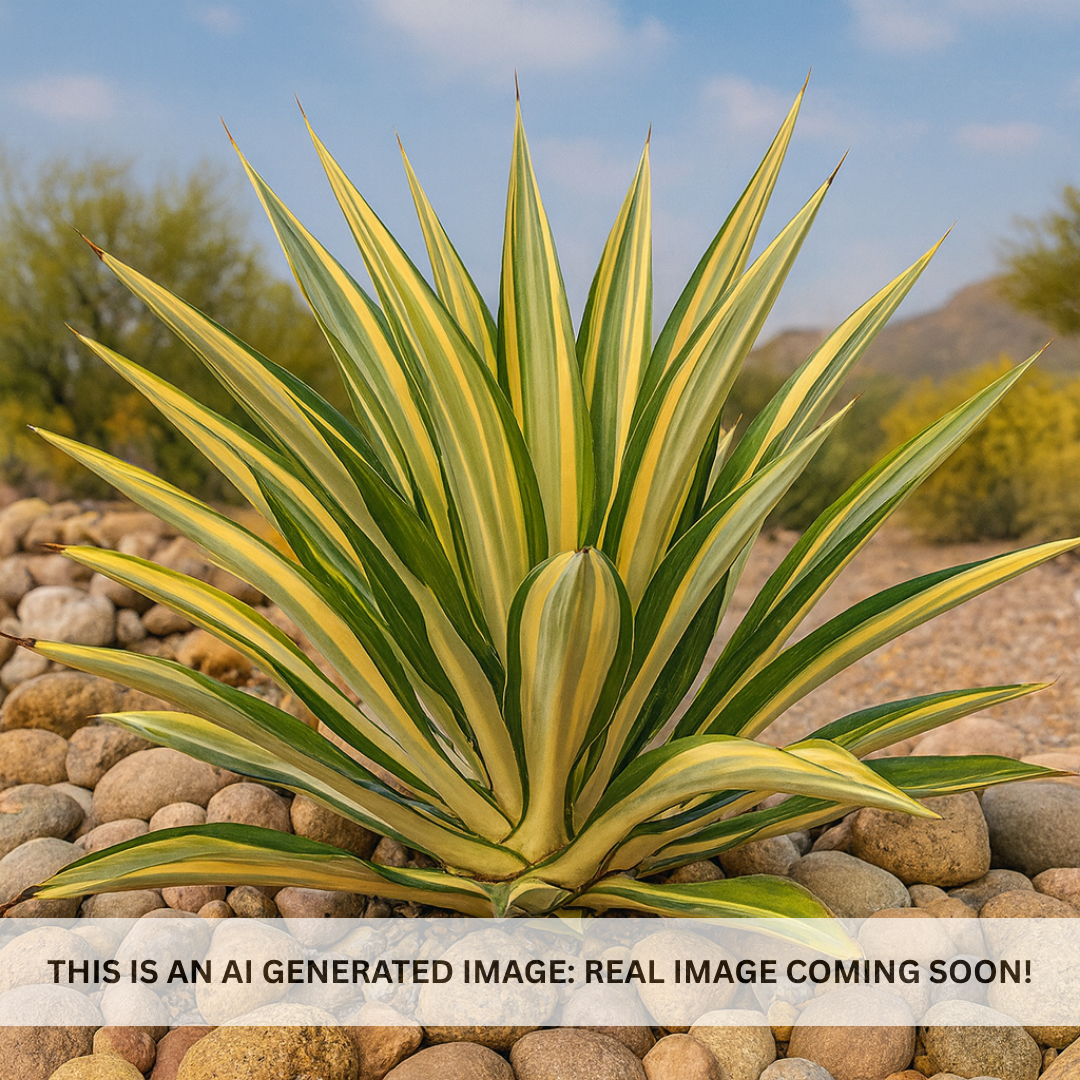My Store
Variegated Furcraea
Variegated Furcraea
Couldn't load pickup availability
Plant Type: perennial, succulent (rosette-forming)
Plant Height: 4–6 feet (flower spike up to 20 feet)
Spread: 5–8 feet
Flower Color: creamy white
Sun Exposure: Full sun, Partial Shade
Variegated Furcraea / Furcraea foetida ‘Medio’: A Striking, Tropical-Desert Accent with Bold Variegation
Furcraea foetida ‘Medio-picta’, commonly called Variegated Furcraea, is an extraordinary architectural succulent prized for its elegant rosette of long, sword-like leaves with creamy yellow centers and green margins. Native to tropical regions of Central and South America, this variety thrives in Arizona’s warm, dry climate and provides a dramatic focal point in both modern and natural desert landscapes. Often mistaken for agave, it differs in having softer, spineless leaves that arch gracefully outward, creating a lush, flowing silhouette that softens hardscapes and rock features.
Key Features of Furcraea foetida ‘Medio’
Variegated Furcraea forms a large rosette of broad, flexible leaves that can reach over 6 feet in length. The leaves display stunning coloration—bright creamy-yellow bands running through their centers bordered by deep green margins. Unlike agaves, the leaves lack sharp spines along the edges, making this plant ideal for high-traffic landscape areas. When mature, it produces an enormous, tree-like flower stalk reaching up to 20 feet tall, adorned with clusters of creamy white, bell-shaped flowers. After blooming, the parent rosette typically dies, but it produces numerous offsets (pups) and bulbils along the flower stalk, ensuring its continuity in the landscape.
Growing and Care Tips
Furcraea foetida ‘Medio’ thrives in full sun but tolerates partial shade, particularly during Arizona’s most intense summer months. It prefers sandy, rocky, or decomposed granite soil with excellent drainage. Once established, it is highly drought-tolerant, though occasional deep watering during summer will promote fuller, more vigorous growth. Avoid overwatering, as standing moisture can lead to crown or root rot. It tolerates light frost down to about 28°F, but the leaves may suffer tip damage during cold snaps; protection or covering during frost events is recommended. In containers, use a large, heavy pot to accommodate its eventual size and deep roots. Remove spent leaves periodically to maintain a clean, sculpted look.
Landscaping Uses
The Variegated Furcraea is a showpiece plant that brings instant elegance and drama to desert landscapes. Its variegated leaves create striking contrast against darker green or blue-gray plants such as Whale’s Tongue Agave, Blue Glow Agave, or Mexican Fencepost Cactus. It performs beautifully as a focal accent in rock gardens, entryways, courtyards, or poolside plantings where its tropical aesthetic enhances modern desert architecture. When used in clusters, it creates a vibrant, textural display that softens hard surfaces and adds year-round visual interest.
Summary
Furcraea foetida ‘Medio’ combines tropical beauty with desert durability. Its luminous variegation, graceful structure, and low water requirements make it one of the most elegant and versatile accent plants for Arizona landscapes. Perfect for homeowners seeking bold design without the harshness of spined agaves, this plant delivers both softness and sophistication while thriving under the desert sun.
Three Timbers Installation Guide (Feel Free to Follow):
Furcraea foetida ‘Medio’ Planting Guide:
Location: Full sun to partial shade; provide at least 6 hours of direct sunlight daily for best color intensity. Partial shade in afternoon heat helps maintain rich leaf tones.
Soil: Use a sharply draining cactus or succulent mix combined with decomposed granite, sand, or pumice. Avoid heavy or clay soils that retain moisture.
Spacing: Allow 6–8 feet between plants to accommodate full rosette spread and future offsets.
Planting Depth: Set the crown level with the soil surface; avoid burying the base of the leaves to prevent rot.
Support: Not required; the rosette naturally maintains a stable base as it matures.
Watering Guide:
Watering After Planting: Water deeply after planting to settle the soil, then let it dry completely before watering again. During establishment (first 2–3 months), water every 10–14 days depending on temperature and exposure.
When is the Plant Established? Furcraea foetida ‘Medio’ is considered established after 6–9 months, once new central leaves begin to emerge steadily and the rosette shows upright fullness.
Watering Once Established: Water sparingly—every 3–4 weeks in hot, dry weather, and less during cooler months. Once mature, it can thrive on natural rainfall alone.
Drip Irrigation Setup: Install one low-flow emitter (0.5–1 gallon per hour) about 10–12 inches from the base. Run infrequently and allow complete soil drying between irrigation cycles.
General Watering Tips: Always confirm that the soil is fully dry before watering again. Overwatering can cause crown rot. Use decorative gravel or decomposed granite as a top dressing to reflect heat, improve drainage, and highlight the variegation—keeping the material several inches away from the crown for airflow and longevity.
Share












